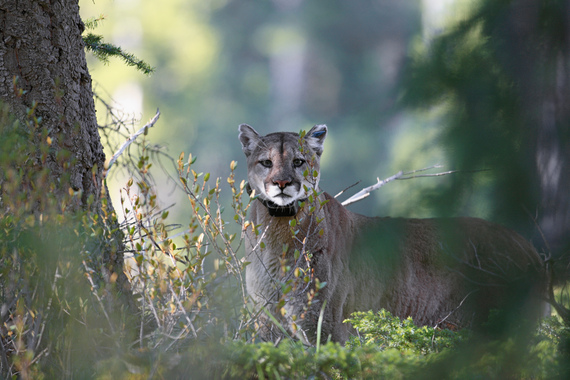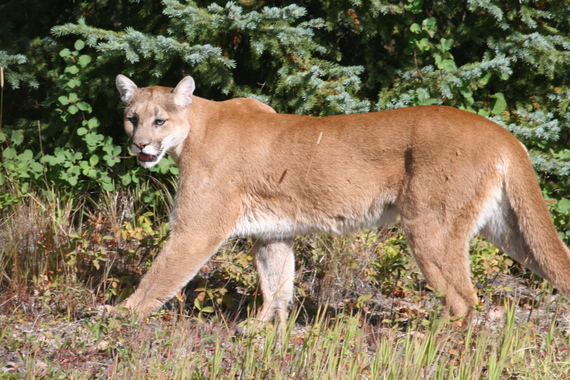 |
| Doug the Cougar, photo by John Marriott |
Overt examples of coexistence between our species are uncommon, because of the cougar's elusiveness. Yet occasionally a legendary animal comes along who provides such an example. In Banff National Park in response to Frances Frost's 2001 death by cougar attack while cross-country skiing, managers radio-collared twelve cougars to study their behavior relative to humans. They had to chase one up five Douglas-fir trees before successfully collaring him. Subsequently dubbed Doug, this 150-pound tom proceeded to teach everyone astonishing lessons about coexistence.
Collar data quickly showed Doug's propensity to hunt near human development. Sometimes he'd kill deer in one of the park picnic areas. These takedowns probably seemed a good idea under cover of darkness, but once the sun came up, Doug found himself amid lots of human activity. Still he continued to hunt in the area.
Managers and the public grew fond of Doug, who never threatened humans. His collar data showed that while in the park backcountry, which had low human activity, he became more diurnal. Banff human-wildlife conflict specialist Steve Michel uses Doug as an example of an animal who learned behavior (e.g., hunting at night) to coexist with humans. Doug eventually died at the ripe age of fourteen, when he fell through the ice while chasing an elk, leaving an untarnished reputation.
My most remarkable cougar lesson occurred one autumn while working in Glacier National Park's North Fork Valley. My field crew and I were staying in a house owned by The Nature Conservancy, just outside the park. The secluded cedar home stood in a large meadow, surrounded by a thick lodgepole forest. The house had no phone or electricity.
We'd just finished a ten-mile day of data collection on my wolf project. I dropped off my hot, hungry crew at the house, leaving them on the porch, and went home to for a rare night with my family. When I returned the next morning, they filled me in on what had happened.
Shortly after I left, a wolf had darted across the meadow. A few seconds later, my crew heard animal screams coming from the forest edge, about fifty yards away--an animal dying. Thirty seconds after that they heard growling and other primal sounds--branches breaking, a battle.
All at once, a cougar exploded out of the forest and headed directly toward them at a full run. It came within ten feet, so close they could see that it was a female. Ears flattened, lips drawn back to expose her sharp teeth, she snarled but didn't make eye contact. They went inside. The house's expansive windows enabled them to watch the cougar safely and take photographs.
North Fork Cougar, Eisenberg Project Photo
Angry was the operative word for that animal. She circled the house, staying very close, but not looking at them. She seemed well-muscled and large for a female, but a bit lean. Fresh welts rose on one of her flanks, but her flesh was unbroken. My crew perceived no threat from her, just intense anger. She circled the house for ten minutes, and then left.
The next morning, all seemed peaceful when I picked up my crew and we left for the field. Upon returning that afternoon, we went into the woods to investigate. Just inside the forest, we found a white-tailed deer carcass surrounded by the dinner-plate-sized tracks of a very large grizzly bear and the smaller tracks of her cub. A welter of cougar tracks mixed with grizzly tracks indicated a skirmish. The bears had worked over the deer, but we could still see its broken neck and torn throat.
Every kill site tells a story. We determined that the grizzly, on the prowl for calories and protein prior to hibernation, had attempted to steal the cougar's kill. This had resulted in an intense battle, during which the grizzly had prevailed. The cougar had bolted out of the woods and run toward the perceived safety of humans--a tired field crew unlacing their boots on the porch. The savvy creature knew a grizzly with a cub wouldn't pursue her toward humans. She'd continued to circle the house long after the crew had gone inside, until she sensed it safe to leave. As for the wolf, we speculated that it had just been passing through, checking out the action.
These stories illustrate the spectrum of cougar relations with humans. Cougars usually exhibit neutral behavior around us, as was the case with Doug. Sometimes they're curious about us. On very rare occasions they see us as prey. And occasionally they use us for protection from other predators--called human shielding.
Recovering cougar populations raise questions about balancing this species' ecological needs with ours. As human and cougar populations continue to expand and cougar habitat becomes increasingly fragmented, what limits should be placed on human activity in the urban-wildland interface? And how do we best manage this stealth predator? Questions from the media after fatal cougar attacks demonstrate that cougar restoration isn't as simple as just wanting them back. Lessons like the ones above reveal astonishing intra-species relationships and that we still have much to learn from this powerful animal.

No comments:
Post a Comment